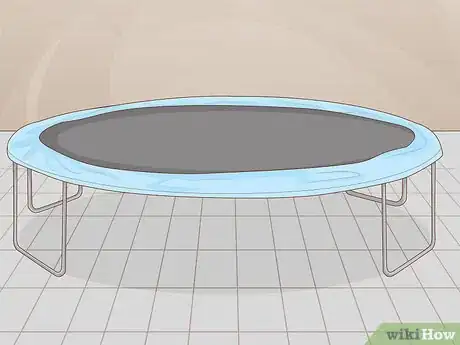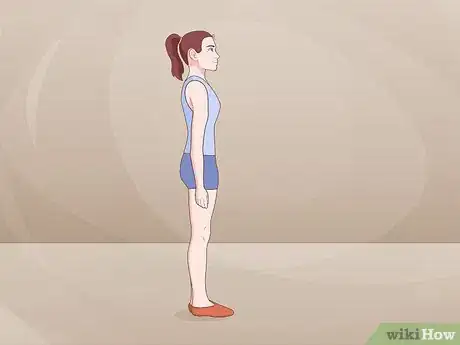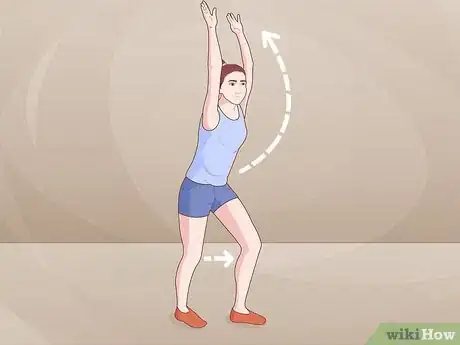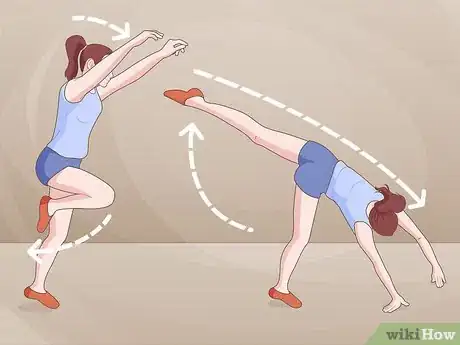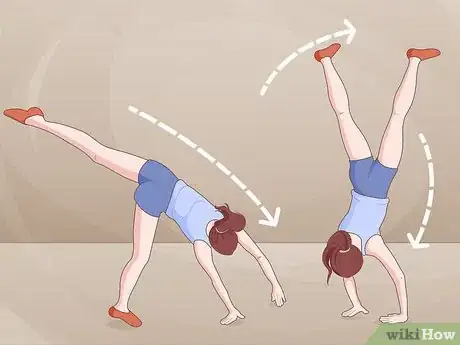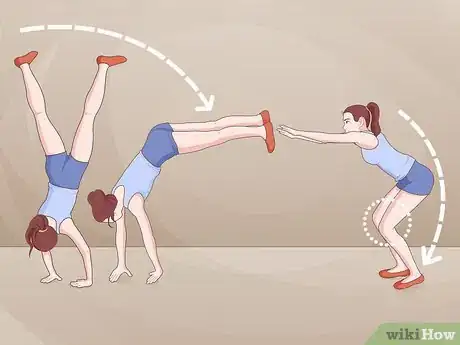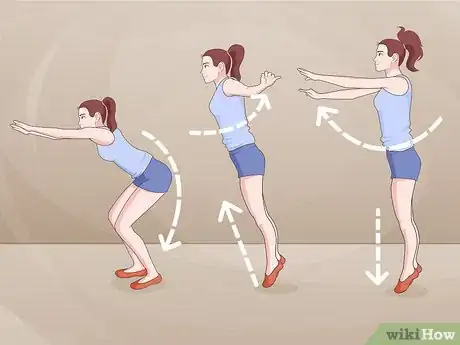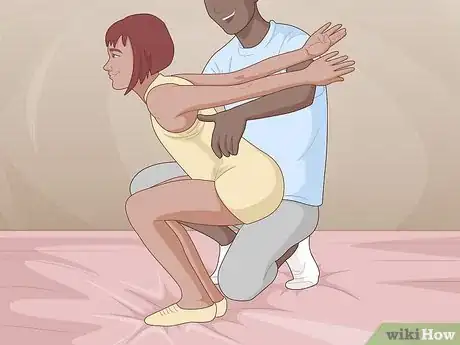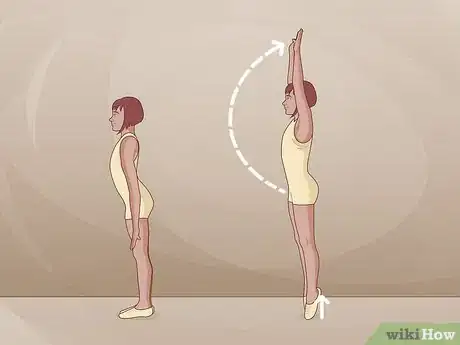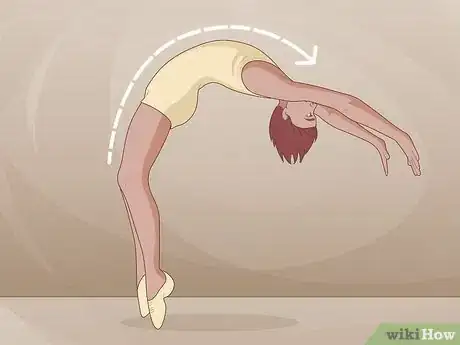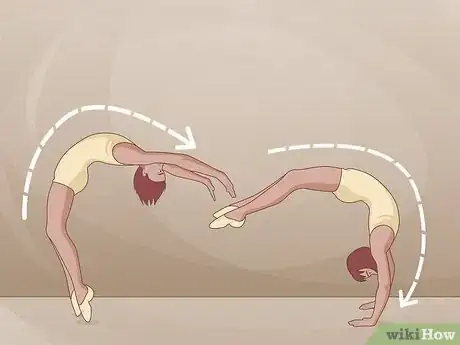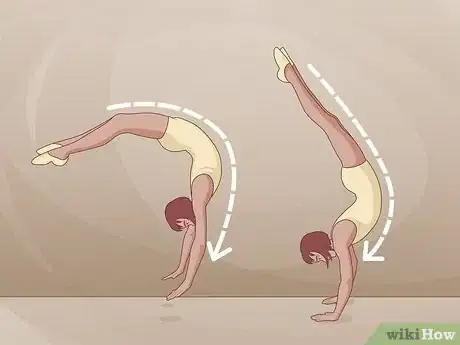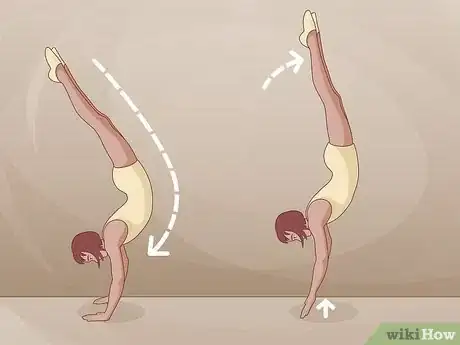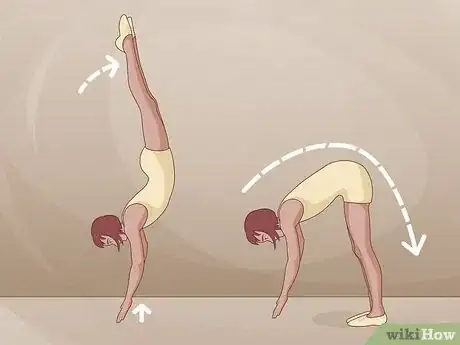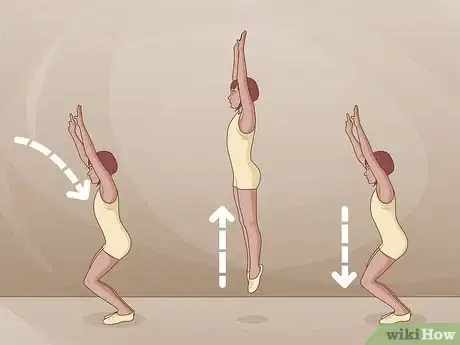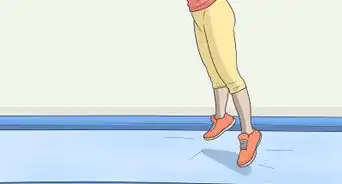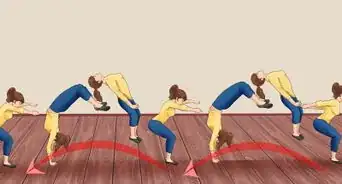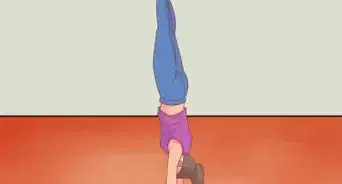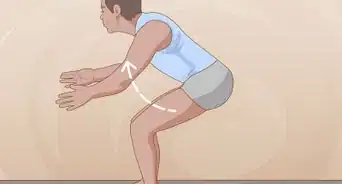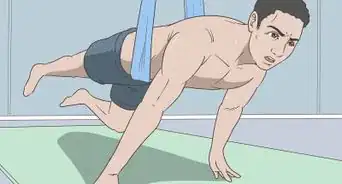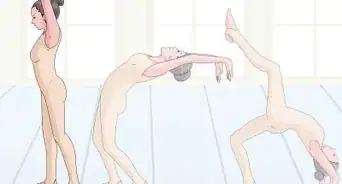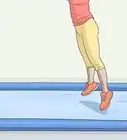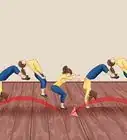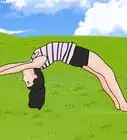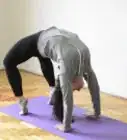This article was co-authored by Rosalind Lutsky, a trusted member of wikiHow's volunteer community. Rosalind Lutsky worked as a gymnastics coach at SB Gymnastics at Stanford University, coaching children from ages 5-12 years old during her time as a Stanford student. She was a competitive gymnast growing up, and competed for her local gymnastics team in Minnesota.
This article has been viewed 145,978 times.
Learn more...
The roundoff back handspring is a gymnastics move that allows you to use the momentum from the basic roundoff to generate a fast and powerful back handspring. Learn how to do these two moves separately before trying to put them together. Practicing them apart and mastering each step will make it easier when it comes time to combine them into one move.
Steps
Perfecting the Basic Roundoff
-
1Use a trampoline or springy surface when you’re first learning the roundoff. Trampolines are great to practice on, as are gymnastics floors, which have springs built in underneath them. It can be helpful to practice on a tumble track while you're learning, which has more give than a gymnastics floor but isn't quite as bouncy as a regular trampoline. Use these softer surfaces to practice good technique and build more confidence while you perfect your roundoff.[1]
- If you’re new to gymnastics or to the roundoff, work with a spotter until you’re comfortable.
- You can even buy mats to use at home if you want to practice when you’re not at the gym.
-
2Stand with your feet together and your arms at your sides. As you prepare for the roundoff, try visualizing yourself moving through the motions and pick a spot on the floor or trampoline where you’d like to land. This can help you get the right momentum and practice with good form as you begin the roundoff.[2]
- A roundoff looks just like a cartwheel but you land on two feet instead of one at a time. You generally need more power for a roundoff than for a cartwheel, and you should push off from the floor with your arms, unlike a cartwheel.
- If you aren’t sure of what the movement is supposed to look like, watch some videos online or ask for a demonstration from a peer.
Advertisement -
3Lunge or run forward and raise your arms above your head. You need to gather momentum for the movement, so run forward a few steps. Swing your arms up so they’re by your ears and keep them as straight as possible. It can help to lead with your dominant foot and end your run with your dominant foot before you move into the roundoff.[3]
- Try not to run too far before you start your roundoff, as this can actually make you lose some energy and momentum.
-
4Reach your arms towards the ground as you hurdle forward. This motion is kind of like doing a cartwheel where your body is turned slightly sideways. Move so that you plant your dominant hand on the ground first.[4]
- Move with forward-motion to place your hands on the ground rather than jumping into the roundoff.
-
5Bring your legs up over your body as your hands hit the floor. Plant your hands firmly on the floor and briefly push up into a handstand while you flip yourself over. Position your body so that your shoulders, arms, and wrists are parallel to the ground.[5]
- Keep your legs as straight as possible.
- If you have trouble with this part, practice doing a handstand on its own to build up the arm strength that you'll need for the roundoff.
-
6Land with your knees bent then jump into a straight-standing position. Move out of the handstand while keeping your legs together. Gently bend your knees, and then spring upwards with your hands above your head.[6]
- When you land, you should be facing the opposite direction from where you started at the beginning of the roundoff.
-
7Practice jumping up after you land the roundoff. To get ready for the back handspring, practice jumping as high as you can every time you land the roundoff. This will help you gain the power and momentum you need to propel yourself into the next move.[7]
- Keep practicing! You need to be really comfortable with this movement so you can put it together with the back handspring. It may be hard at first, but with practice, you’ll get better.
Adding the Back Handspring
-
1Have someone spot you on the back handspring before you try it alone. Always put your safety first when working on new movements. Ask a coach or experienced friend or parent to work with you and help spot you as you learn the back handspring or add it to your roundoff.[8]
- Use an octagonal mat to practice the back handspring on its own or use it to practice adding the back handspring to the roundoff.
- Land your roundoff just before the mat so you can practice extending backward into the back handspring.
-
2Push through your toes and swing your arms up as you begin the back handspring. Swing your arms up over your head as you come out of the roundoff and into the back handspring. As you jump into the back handspring, think about moving your body backward more than straight up into the air.[9]
- Your momentum comes from backward movement. Be sure to get a little height for your back handspring but not too much. If you jump straight up, it’ll actually be harder to complete the move and you'll lose some momentum.
-
3Flip backward as your arms swing back by your head. Try to avoid over-arching your back, and instead carry your power through your arms and torso. Use your legs to drive you upward and backward, and keep your toes pointed.[10]
- Try to keep your core as tight as you can while you complete the back handspring. This will make your movements more precise and will help you power through the tumbling pass.
- Have a spotter help you as you practice. They will help support your weight through the back handspring to make sure you're safe and using good form.
- Remember that you can use the tumble track or an octagonal map to help you practice before you try it on the floor.
-
4Plant your hands on the floor. As you flip backward, let your hands touch the floor as your body stays arched. Keep your arms as straight as possible so your head doesn’t hit the ground. Place your palms flat against the floor so your fingers are pointed away from your head, and let the momentum of your legs propel your body backward.[11]
- Keep your head down between your arms.
- Try to keep your legs together and keep your toes pointed.
-
5Swing your legs over your hands into a brief handstand. This is a really quick moment and you don’t need to hold the handstand, but it can help to visualize it to get your body in the right position. Your legs and shoulders should be lined up as you flip over.[12]
- Try to keep the soles of your feet parallel to the ceiling as you hit the middle of the back handspring.
-
6Push yourself off the ground with your arms. Use both your momentum and your arm strength to push yourself off the ground from the brief handstand. At this point, your legs should be swinging down, as you finish the back handspring.
-
7Plant your feet on the ground as you land. Keep the momentum going and swing your legs and feet all the way over. As you land, bring your chest up and make sure your arms are straight and tight by your head. When you land, let your legs bend a little bit so you don’t fall.[13]
- Keep your upper body as straight as possible to help you keep your balance.
- Try to keep your legs together as much as you can throughout the back handspring.
-
8End by popping up and doing the finishing pose. Swing your arms straight in front of you as you pop up, and then place them up above your head when you land. Your feet should be next to each other and not wide apart.[14]
- Keep practicing your movements and don’t worry if it takes you a while to get things down. If you keep working hard, you’ll be able to do the entire roundoff back handspring in no time.
Community Q&A
-
QuestionWhy do I have to lean back?
 Community AnswerYou have to lean back because it will help your legs power up and push off the surface you're doing the handspring on.
Community AnswerYou have to lean back because it will help your legs power up and push off the surface you're doing the handspring on. -
QuestionHow do I go down, and how do I get rid of the fears?
 Community AnswerOne tip is to fall back on something soft to practice falling and your fear of going over. A back walkover can help you go over in a back handspring.
Community AnswerOne tip is to fall back on something soft to practice falling and your fear of going over. A back walkover can help you go over in a back handspring. -
QuestionShould you always make sure you have a spotter the first few times to get your confidence about going backwards?
 Community AnswerThat's how everyone starts out. Once you're more confident, you can throw it by yourself.
Community AnswerThat's how everyone starts out. Once you're more confident, you can throw it by yourself.
Warnings
- Always work with a spotter until you are confident and experienced enough to pull off the roundoff back handspring by yourself and always have someone you trust along with you.⧼thumbs_response⧽
References
- ↑ https://kidshealth.org/en/teens/safety-gymnastics.html
- ↑ https://www.sportsrec.com/1002177-to-perfect-roundoff-back-tuck.html
- ↑ https://www.sportsrec.com/1002177-to-perfect-roundoff-back-tuck.html
- ↑ https://www.sportsrec.com/1002177-to-perfect-roundoff-back-tuck.html
- ↑ https://www.sportsrec.com/1002177-to-perfect-roundoff-back-tuck.html
- ↑ https://www.sportsrec.com/1002177-to-perfect-roundoff-back-tuck.html
- ↑ https://www.sportsrec.com/1002177-to-perfect-roundoff-back-tuck.html
- ↑ https://kidshealth.org/en/teens/safety-gymnastics.html
- ↑ https://www.sportsrec.com/do-back-handspring-home-beginners-8197605.html
- ↑ https://www.sportsrec.com/do-back-handspring-home-beginners-8197605.html
- ↑ https://www.sportsrec.com/do-back-handspring-home-beginners-8197605.html
- ↑ https://www.sportsrec.com/do-back-handspring-home-beginners-8197605.html
- ↑ https://www.sportsrec.com/do-back-handspring-home-beginners-8197605.html
- ↑ https://www.sportsrec.com/do-back-handspring-home-beginners-8197605.html
